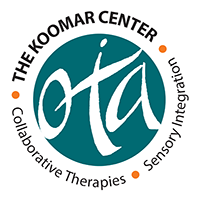Adult Occupational Therapy Services
Adults and Sensory Integration
Many adults have sensory processing disorders that make daily activities challenging or even impossible. For example, auditory sensitivities may interfere with the ability to work, ride public transportation, and participate in family activities. Tactile defensiveness often creates difficulties with intimacy with a spouse or significant other and frequently affects interpersonal relationships with friends, co-workers, and family. Difficulties processing vestibular input (movement) can affect the ability to drive, ride in airplanes, and engage in daily activities such as descending stairs, riding a bike, walking on uneven surfaces (e.g., when hiking), and navigating terrain such as icy sidewalks (Kinnealey, Oliver, & Wilbarger, 1995). Adults with sensory processing challenges, especially those with sensory defensiveness, often present to others as being controlling, picky, and overly sensitive (Oliver, 1990). They often report high levels of anxiety and depression, commonly have a history of post-traumatic stress disorder (PTSD) or trauma (Kinnealey & Fuiek, 1999), and may have tried years of counseling and medication before arriving at occupational therapy.
OTA The Koomar Center offers the highest quality services to adults within the fields of Occupational Therapy and Speech and Language Therapy. This page describes the different types of Occupational Therapy evaluations that are offered at OTA as well as information on our intervention approaches.

Occupational Therapy Evaluation
Comprehensive OT Evaluation
Specialty OT Evaluation
Abriged OT Evaluation
OT Screening
For individuals who are new to OTA, an occupational therapy screening might be recommended during the intake process if it is unclear if the reported concerns are sensory related. In this case, a screening can take place as a first step instead of a comprehensive evaluation. The results of the screening will guide if a comprehensive evaluation is recommended.
A screening consists of a 1-hour screening session; a feedback checklist is provided at the end of the screening.
Occupational Therapy Intervention
Individual Occupational Therapy Intervention
The occupational therapy intervention provided at OTA is tailored to meet the unique needs of everyone we work with. During therapy sessions with adults, therapists use the core tenants of sensory integration to address specific sensory motor areas to improve functional capacities. This includes providing enhanced and targeted sensory input at the “just right” level to promote an organized and developed nervous system; working in the context of meaningful activities and goals that are motivating and engaging; establishing a collaborative therapeutic relationship that allows for growth in a physically and emotionally safe environment. Utilizing these tenants, you will work together alongside your therapist to improve the sensory motor foundations needed to improve a range of functional skills including:
- Completion of daily activities, routines, and roles
- Organization and planning skills
- Participation in social and work settings
- Sleep and eating patterns
- Engaging in new activities more comfortably
- Accepting everyday sensations including clothing and noisy environments
Sessions take shape based on each person’s unique needs and learning style. They can include remediation-based sensory activities, development of home programs and accommodations, and education. Your therapist will be thoughtful about what other factors might need to be considered to support your individual needs, including room set up and environment. Your therapist will also consider and utilize a range of approaches during therapy to support your unique needs including listening programs, oral motor techniques, manual therapies, and visual vestibular modalities.
Our hour-long therapy sessions encompass direct care, education, and recommendations for support in functional settings. Additional supplemental services, including collaboration and meeting with family and team members, are also available to comprehensively provide support to meet their ongoing needs. The development of functional goals and objectives for everyone who receives services at OTA is a very important part of the treatment planning process. We look forward to meeting with you during the first month of therapy to establish functional goals that will be measured by improvement in day-to-day skills and activities.
Specialty Occupational Therapy Interventions
The FOCUS Program – Oral Motor/Feeding Intervention
Many adults experience eating difficulties brought on by physical, sensory and psychosocial factors. Restrictive eating patterns negatively impact an individual’s social, emotional, and dietary well-being. Occupational Therapists at the FOCUS Institute for Mealtime Success have specialized training and utilize the FOCUS Program, a whole-body, systematic approach developed to address the complex and multifaceted needs of clients who experience challenges around mealtime. Eating is a complex and multisystem skill, therefore, FOCUS practitioners believe it is not helpful to target treatments solely on the individual’s mouth, but to consider the individual’s whole body and all environmental, contextual, physical, and psychological causes as part of a collaborative and systematic approach to treatment. Click here to learn if you would benefit from our services. For more information about the FOCUS Program, click here.
Listening Interventions
Visual Vestibular Intervention
- Difficulty driving (reading road signs, merging on the highway)
- A dislike of flying in airplanes
- Difficulty “getting it together” throughout each day
- Motion sickness in cars, airplanes or boats
- Needing to spend a lot of time and energy getting organized
- Discomfort if not in front seat while riding in a car
- Fear of heights
- Loss of balance when a bus or subway stops quickly
- Difficulty navigating through grocery store, department store or mall
- Difficulty with maps and directions
Click here for more information on visual-vestibular integration.
Manual Therapies
Many therapists at The Koomar Center specialize in manual therapies and routinely use these techniques as an integral part of therapy sessions. Sessions specifically devoted to manual therapy are also offered. These sessions may precede or follow regularly scheduled sensory integration sessions, depending upon the individual’s tolerance. Click here for more information.
